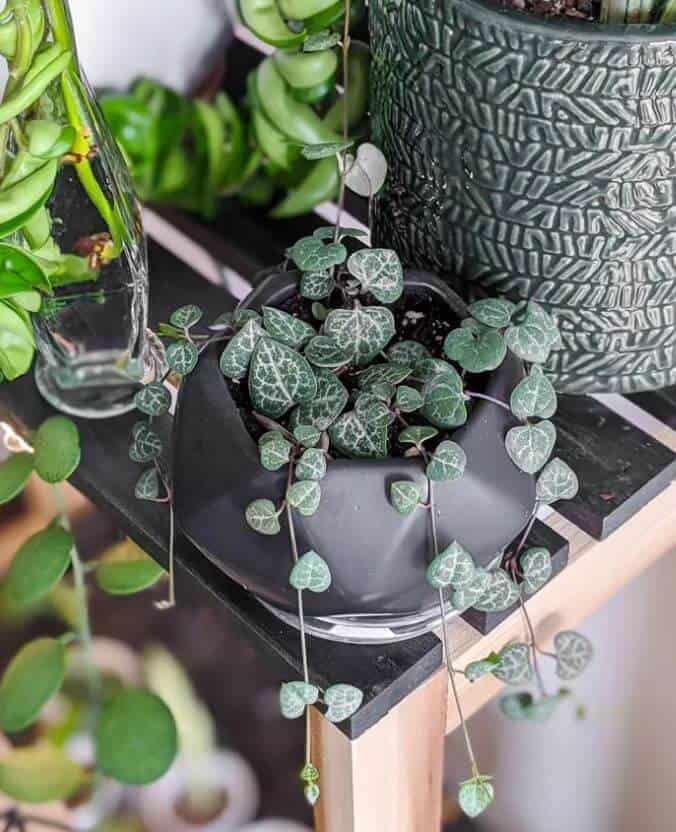Last Updated on September 9, 2023 by a Friendly Gardener
If you have a String of Hearts Plant or are thinking of cultivating one, how you water it should be a priority as many of the plant’s problems are connected to watering. Usually sold as a hanging plant, this plant is a succulent that does not require a lot of water but does require consistently damp soil to thrive. Planters should have sufficient drainage holes to ensure that soil does not become waterlogged or soggy.
Botanically known as the Ceropegia Woodii, this South African native is a popular plant for its characteristic heart-shaped leaves. The String of Hearts is relatively easy to care for, but like all houseplants, it does have likes and dislikes.
Problems for a String of Hearts Plant
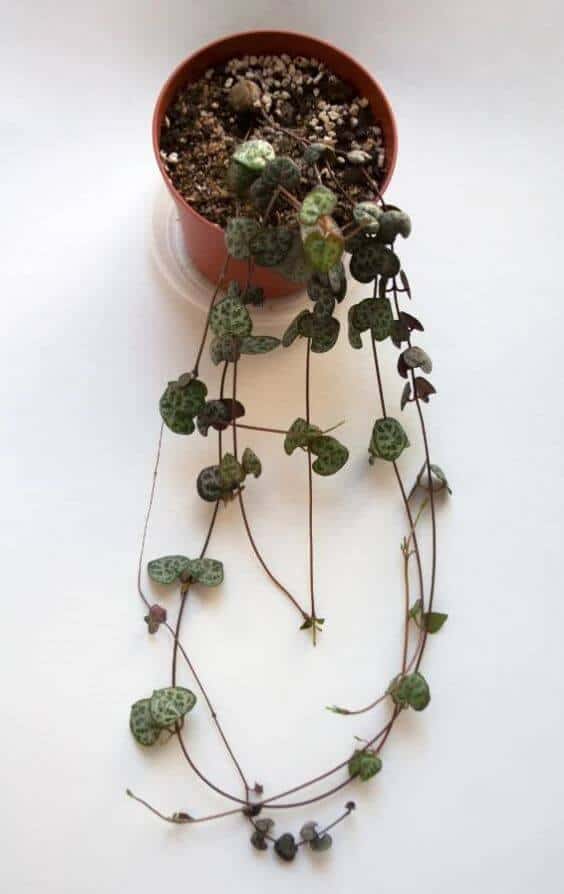
Several of the most common problems for this houseplant include:
• String of Hearts leaves curling
If String of Hearts foliage begins to curl it may indicate that your plant is getting insufficient light. This may be more common to houseplants, as plants grown outdoors tend to develop thicker leaves, so they curl less. Curling is not necessarily detrimental to the plant’s health but will distort its appearance.
Newer growth and the foliage of younger plants may tend to curl a bit. If you wish to contrast this, move your plant closer to the light source.
Pests like aphids, mealybugs, spiders, and insect eggs can also cause curling. Watch for pests and treat your plant with insecticidal soap if warranted.
• Overwatered String of Hearts plant
The Ceropegia Woodii does not respond well to overwatering. It is a succulent, so it stores some water. String of Hearts wrinkled leaves is a typical response to your plant sitting in soggy soil.
While you should not go to the other extreme and risk underwatering your plant, evaluate your watering schedule and adjust it. Depending on how soggy the soil is, you can either allow it to dry somewhat or repot your plant in fresh soil.
Another common symptom of overwatering is yellow leaves although cold temperatures will also produce this reaction. If you think the environmental temperature is a problem, relocate your plant.
• Underwatered String of Hearts Plant
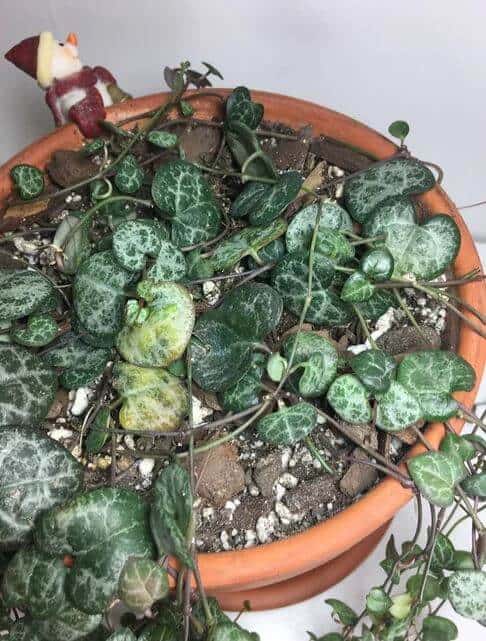
A lack of suppleness in foliage is a sign that your plant needs watering. Shriveled foliage, crispy brown leaf edges, yellowing leaves, and a lack of vine growth or overly small leaves are all indications of an underwatered String of Hearts. Your plant may also appear to sag without adequate watering. To aid your underwatered plant, remove any damaged leaves.
Consider changing the soil as it will often become hardened if it has dried out completely especially if you have used standard potting soil instead of a growing medium formulated for cacti and succulents.
Water sparingly but regularly and preferably from the plant’s bottom. You may want to soak your plant when watering but allow all excess water to drain completely. Terracotta containers will aid with the evaporation of excess moisture.
Consider that these plants will need to be watered as often as twice a week during warmer weather. When fall arrives, reduce watering to every two weeks as the String of Hearts will enter dormancy.
• Drying Foliage
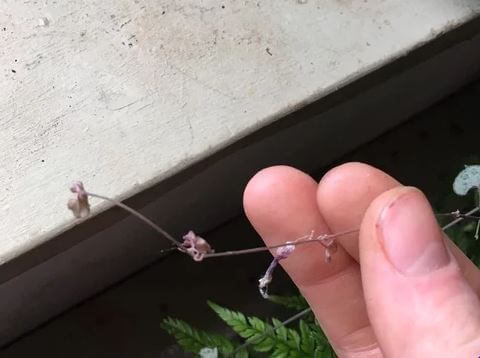
This is probably one of the most common problems seen with a String of Hearts plant. Although this plant is a succulent, it still requires regular watering scheduling. If you witness the leaves of the String of Hearts shriveling and drying, you are keeping your plant too dry.
This is especially true for younger plants and new growth because leaves are thin and do not store much water. More mature foliage will store more water and deal with drought conditions better.
With drying foliage, the problem is almost always water. Occasionally it may indicate that your plant is receiving too much sun or that it is root-bound. In this case, leaves will dry and then drop.
• Leaf Drop
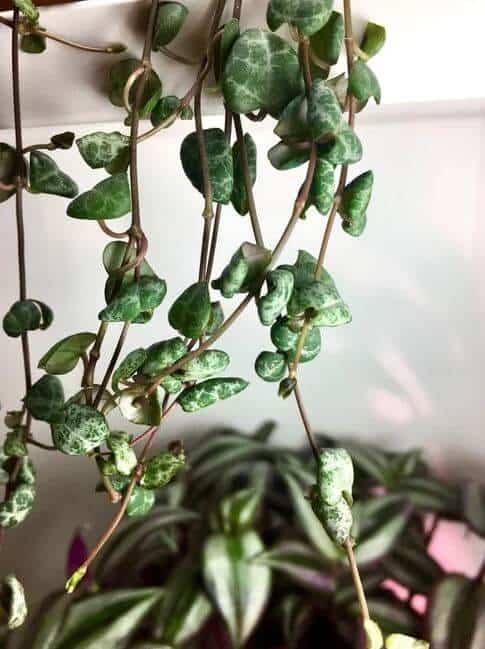
Leaf drop can be a reaction to several problems. The most common reason is overwatering, especially if your leaves turn yellow before they drop. It may not be your watering schedule but may be a drainage problem. You can adjust drainage by adding perlite to the growing medium. Check the container’s drainage holes, add a layer of pebbles to the bottom of the container, and opt for a terracotta container.
Underwatering can also contribute to leaf drop. In this case, adjust your watering routine.
Inadequate sunlight is another reason for leaf drop. The String of Hearts can manage in a shady spot but not in consistently low light conditions. Vines will appear leggy, and foliage may become paler, so you’ll know if a lack of light is the problem. Look for a spot with bright indirect light. Do not expose your plant to direct sun as leaves may suffer scorching.
A further cause of leaf drop might be a shock because the location temperatures are too cold. Your plant should not be placed near vents or air conditioning units. Try and keep your plant in an environment with temperatures measuring between 70° to 85° F. The temperature should never drop below 60°F. or your plant will suffer and decline.
Surprisingly, even environmental shock can lead to leaf drop. If you have changed your plant’s location or even moved, your plant may react badly. If the leaf drop continues for more than a week or two, check the roots for disease.
• Scorching
If your plant has been overexposed to sunlight and experienced sunburn, remove burnt foliage and relocate your plant. Damaged foliage will not heal or revive.
My String of Hearts Plant Seems to be Dying

The principal reason that a plant begins to die is overwatering which leads to root rot. Root rot leads to mushy roots and vines and the roots will no longer be able to send necessary nutrients to all parts of the plant. The String of Hearts may emit an unpleasant smell. In the case of root rot, you will need to repot your plant. Remove the plant, prune away any affected roots, and replant your String of Hearts in a fresh growing medium.

